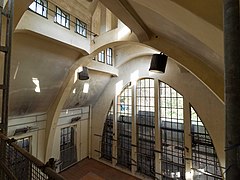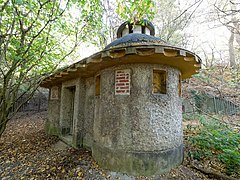Former sewage treatment plant Krefeld
| Former sewage treatment plant of the city of Krefeld | |
|---|---|
| use | is z. Currently refurbished (February 17, 2019) |
| location | |
| city | Krefeld |
| address | Loop 20 47829 Krefeld |
| 51 ° 20 '50.6 " N , 6 ° 38' 17.6" E | |
| Structural data | |
| architect | Jörg Bruggaier |
| Construction year | 1908-1909 |
| Architectural style | Art Nouveau |
| Monument protection | Yes |
The former Krefeld sewage treatment plant is a listed building in the North Rhine-Westphalian city of Krefeld . It was built near the city limits of Krefeld-Bockum on a plot of land in the independent and much older Rhine city of Uerdingen , later it belonged to the city of Krefeld-Uerdingen on the Rhine , today it is in the Krefeld-Uerdingen district on Rundweg 20-22.
The Crefeld cleaning plant , as it was previously called, was used to clean the wastewater from the city center of Krefeld, the Krefeld districts of Bockum and Linn and the city's industry. It is considered an architectural testimony to Art Nouveau in industrial construction. It is one of the first buildings in the world in which a hall structure in different parabolas was executed monolithically in reinforced concrete.
With the Niederrad sewage treatment plant in Frankfurt am Main in Germany and the Stara Cistirna sewage treatment plant in Prague Bubenec in the Czech Republic , it is one of the last three remaining sewage treatment plants from the founding time of the city drainage system.
history
The sewage treatment plant was probably built between 1908 and 1909 according to plans by the architect Georg Bruggaier. The inventory drawings that have been preserved also come from Bruggaier, but building plans are not available. Other parties involved were the deputy senior building officer Hubert Hentrich , the city engineer Dr. Ing.Krawinkel and Lord Mayor Dr. Adalbert Oehler. The construction company carrying out the very early monolithic reinforced concrete structure is still unknown, and construction files from the city of Krefeld are no longer available. However, it must have been one of the few reinforced concrete pioneers.
The construction costs at that time (converted) amounted to around 1.3 million euros.
The former sewage treatment plant consists of the following parts of the building:
- Clarification hall (main building), consisting of an entrance portal (with integrated ancillary rooms), three sewage sewers, a truck, three gate valves and an indoor crane.
- the adjacent machine house, consisting of a corridor, hall of the flood pumping station, workshop, magazine and transformer room
- Bremsberghaus, adjoining the clarification hall, was used to overcome the difference in height in order to raise the clarified material to the level of the landscape using carts
- Works manager's house (living space approx. 74 m² - built in 1921/1922 according to plans by the architect Anton Rumpen)
- Schieberhaus, is still in the administration of the Krefeld AöR municipal company for wastewater-related reasons and today serves as access to the rainwater overflow.
- The total usable area is approx. 857 m².
From 1910 to 1962, the sewage treatment plant was used in its original condition as a mechanical cleaning system for wastewater treatment using fine rakes with a 5 mm gap. This process of mechanically cleaning the wastewater using rakes or sieves was the most common type of wastewater treatment in Germany when the sewage treatment plant was built. This process is still used today in the first of many purification stages in modern sewage treatment plants. In 1962, the wastewater treatment of the city of Krefeld ended with the shutdown of the sewage treatment plant. The wastewater was discharged uncleaned into the Rhine. The flood pumping station remained in operation until it was replaced in 1972 by a system that still exists today, directly on the banks of the Rhine between Uerdingen and Chempark Uerdingen .
It was not until 1974 that a new sewage treatment plant for Krefeld was put into operation as a second sewage treatment plant, just like the old plant initially operated exclusively with mechanical wastewater treatment. It was not until 1981 that a biological treatment stage was put into operation as a further wastewater treatment stage. From around 1976 the historic sewage treatment plant was converted into a pure sewage pumping station by installing screw pumps and thus once again put into the service of city drainage, until this function was replaced in 1996 by a new underground pumping station immediately next to it after years of planning and construction delays. The wastewater, still arriving in the historical canals at the old first sewage treatment plant, is pumped to the second sewage treatment plant in the city of Krefeld on Lake Elfrather . At that time, ceramic artists from the Niederrhein University of Applied Sciences used the former machine house under the name "Klärwerk-Keramik" as their workshop and studio.
In the phase of the conversion as a sewage pumping station, the structure and the fixtures of the sewage treatment hall were severely damaged by contamination and biogenic sulfuric acid corrosion. The materials used in the sewage treatment hall, reinforced concrete structures, technical fittings such as gate valves and cranes and the terrazzo floor were attacked by sulfuric acid , among other things . The cause was the microbiological conversion in the wastewater that was pumped into the hall and thus led to a combined chemical-biological attack on the surfaces. Dischargers who introduced this new quality of wastewater into the sewer system are so far unknown.
After the sewage treatment plant was decommissioned in 1996, experts created extensive documentation of the damage that had occurred and offers for rehabilitation were obtained. However, this was never carried out by the city of Krefeld. After another 20 years of vacancy and progressive vandalism, the sewage treatment plant became more well known among Urbexers . In 2018, after four years of negotiations with the city of Krefeld, four private owners bought the sewage treatment plant. Since then it has been repaired and is already accessible during guided tours. The monument funding of the state of North Rhine-Westphalia and a special monument program of the federal government support this work.
Picture gallery
- Tour through the parts of the building of the former Uerdingen pumping station (Oct. 17, 2018)
Sightseeing
The interior of the building is only accessible during the renovation as part of guided tours ( visit ).
Web links
- Website of the sewage treatment plant www.klaerwerk-krefeld.org
- “The dead live longer - the old sewage treatment plant in Uerdingen” in kr-one.de
- “New life for the old sewage treatment plant on the Rundweg” in wz.de.
- “Old sewage treatment plant in Uerdingen - the last chance for an almost forgotten gem” in wz.de.
- “The Uerdinger sewage treatment plant” at horst-peterburs.de
- “Frills on the temples of work” in kultur-in-krefeld.de
- "The old sewage treatment plant" at lipinski.de
Individual evidence
- ↑ Georg Bruggaier. In: arch INFORM .
- ↑ "Brozetafel", klaerwerk-krefeld.org
- ↑ "Esseners buy old sewage works" in wz.de
- ↑ Sales expose of the city of Krefeld (07.07.2011) (PDF)
- ↑ Development plan of the city of Krefeld No. 782 - former sewage treatment plant Uerdingen, south of Rundweg ( page no longer available , search in web archives ) Info: The link was automatically marked as defective. Please check the link according to the instructions and then remove this notice. (PDF)







